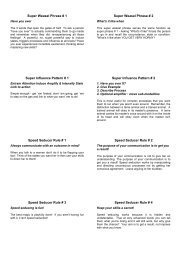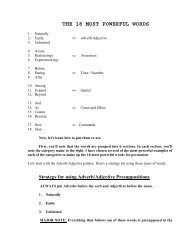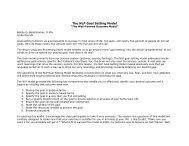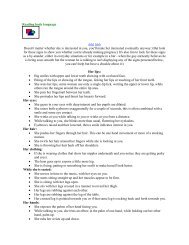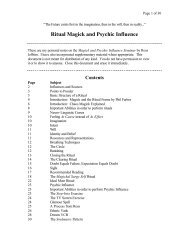A Pragmatic Guide To Communication & Change.pdf - NLP Info Centre
A Pragmatic Guide To Communication & Change.pdf - NLP Info Centre
A Pragmatic Guide To Communication & Change.pdf - NLP Info Centre
- No tags were found...
Create successful ePaper yourself
Turn your PDF publications into a flip-book with our unique Google optimized e-Paper software.
olfactory, and kinesthetic cues also. A lot of touching goes on during<br />
conversations in the Middle East....<br />
General positioning in relation to others for "tonals" and "digibds" is less consistent,<br />
though they will both tend to place themselves close enough to hear. Also, for "digitals,"<br />
both physical and eye contact are avoided. It may be that visual input distracts the<br />
"digital" from the high concentration necessary to maintain control over his verbal output<br />
while a touch has the potential to "reconnect" him with the feelings from which he is<br />
dissociated. Where "digitals" and "visuals" will gaze above the heads of others -<br />
"thinking" and "searching for the correct words to say"- "tonals" tend to avert their eyes<br />
down and away from the speaker, also in order to keep from being distracted, though<br />
more often during listening than speaking.<br />
<strong>To</strong>uching<br />
Those who habitually communicate from the digital category can be thought of<br />
as having<br />
56<br />
those of a "visual," that is, higher up in the chest. The digital system is based on language,<br />
a behavior which is acquired as a person matures. A "digital" person, like a "visual," is<br />
dissociated from his feelings. Since faculty with language comes somewhat later in life<br />
than visual, tonal, and kinesthetic abilities, it may be that a person becomes "digitalized"<br />
in response to some environmental situation. Most "digitals" that I have observed have<br />
physical body types similar to a "kino's." This suggests the adoption of the digital system<br />
as a means of coping (through dissociation) with feelings which may not be pleasant.<br />
Figure 2 - 4 illustrates some of the qualities of a "digital."<br />
One interesting characteristic which seems to correlate with a person's communication<br />
category is the size of the lips. This is especially true of the lower lip. You may find it<br />
interesting to match this phenomena with your own observations. Visually oriented<br />
persons are often characterized by rather thin, tight lips. People operating out of the<br />
kinesthetic category usually demonstrate fuller, softer lips. "'fonals" and `digitals" vary,<br />
however, the latter tending more toward thinner and tighter lips.<br />
Voice: Brief Analysis<br />
"Kinos," on the other hand, in order to breathe as deeply as they do, must open up<br />
the windpipe more. This can give their voices a more breathy or airy quality when<br />
they speak. This relaxation of the throat may also add to the tendency to speak at a<br />
slower pace than the other categories.<br />
Remember, we all have the ability to "be" any one or even a combination of each of<br />
these categories at different times. Even the habitual "visual," "kino," "tonal," and<br />
"digital" can fluctuate, making body type or build unreliable. Rather than depending on<br />
a highly generalized model, it is always better to maintain open and clear perceptual<br />
channels and trust your own experience.<br />
Other Behavioral Cues<br />
'<strong>To</strong>re are certain patterns of behavior which seem to be consistent within each of the<br />
communication categories, particularly in stressful situations. A person who is being<br />
visual" pays most attention to the visual aspects of an interaction. This includes both the<br />
facial expressions and other gestures and movements of those around him as well as his<br />
own internally generated visual imagery. In order to adequately attend to someone he is








